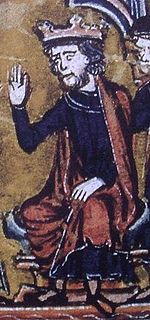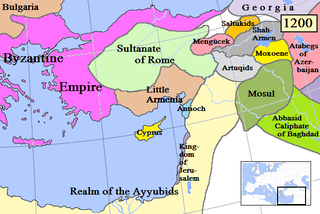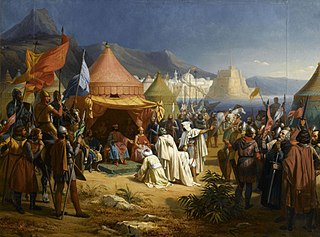Reign
Duqaq was a son of the Seljuq ruler of Syria, Tutush I, and Khatun Safwat al-Mulk, He was the brother of Radwan. When their father died in 1095, Radwan claimed Syria for himself, and Duqaq initially inherited territory in the Jezirah and lived with his brother in Aleppo. However, he soon rebelled and seized control of Damascus, throwing Syria into near anarchy and civil war. Duqaq had the support of Yaghi-Siyan of Antioch, who had no quarrel with Radwan but disliked Radwan's atabeg Janah ad-Dawla; joining Yaghi-Siyan and Duqaq was Ilghazi, governor of Jerusalem. Radwan allied with Ilghazi's brother Sökmen of Artukids.
Radwan attacked Yaghi-Siyan, and when Duqaq and Ilghazi came to assist him, Radwan besieged Damascus as well. However, Radwan soon quarrelled with Janah ad-Dawla, who captured Homs from him, and with his atabeg out of the alliance, Yaghi-Siyan was much more willing to assist him. This new alliance was sealed with a marriage between Radwan and Yaghi-Siyan's daughter. The two were about to attack Shaizar when they heard of the arrival of the First Crusade; all the various alliances were disbanded and everyone returned to their own cities, though if any of the alliances had remained intact, or they had all worked together, they would likely have been able to prevent the success of the crusade.
Over the winter of 1097–1098, Antioch was besieged by the Crusaders, and Yaghi-Siyan and his son Shams ad-Dawla sought help from Duqaq. On December 30, 1097, reinforcements from Duqaq were defeated by the foraging party of Bohemund of Taranto, and Duqaq retreated to Homs. Duqaq later joined Kerbogha of Mosul to attack the crusaders after they had occupied Antioch in June 1098, but during the battle, Duqaq's line deserted and Kerbogha was defeated. While occupied in Syria, Duqaq's possessions in the Jezirah were seized by some rebellious vassals; in 1099 he recaptured Diyarbakr.
In 1100, Duqaq ambushed Baldwin I of Edessa at Nahr al-Kalb, outside Beirut, while the latter was on his way to Jerusalem to succeed his brother Godfrey of Bouillon as king. Baldwin's men held a narrow pass and Duqaq's troops were not able to break through; Baldwin was victorious and continued on to Jerusalem.
In 1103, Duqaq captured Homs when Janah ad-Dawla, Radwan's former atabeg, was assassinated. Duqaq fell sick in 1104, and on the advice of his mother, appointed his own atabeg Toghtekin as atabeg to his young son Tutush II. Duqaq died on June 8 of that year. Toghtegin soon overthrew Duqaq's dynasty to establish the Burid dynasty, which would rule Damascus for the next half-century.

Imad al-Din Zengi, also romanized as Zangi, Zengui, Zenki, and Zanki, was an Oghuz Turkish atabeg who ruled Mosul, Aleppo, Hama, and, later, Edessa. He was the namesake of the Zengid dynasty.

Baldwin II, also known as Baldwin of Bourcq or Bourg, was Count of Edessa from 1100 to 1118, and King of Jerusalem from 1118 until his death. He accompanied Godfrey of Bouillon, and Baldwin of Boulogne, to the Holy Land during the First Crusade. He succeeded Baldwin of Boulogne as the second count of Edessa when he left the county for Jerusalem following his brother's death. He was captured at the Battle of Harran in 1104. He was held first by Sökmen of Mardin, then by Jikirmish of Mosul, and finally by Jawali Saqawa. During his captivity, Tancred, the Crusader ruler of the Principality of Antioch, and Tancred's cousin, Richard of Salerno, governed Edessa as Baldwin's regents.
Abu Sa'id Taj ad-Dawla Tutush I was the Seljuq emir of Damascus from 1078 to 1092, and Seljuq sultan of Damascus from 1092 to 1094.
Fakhr al-Mulk Radwan ibn Tutush was a Seljuq ruler of Aleppo from 1095 to 1113.

The Siege of Antioch took place during the First Crusade in 1097 and 1098. The first siege, by the crusaders against the Muslim-held city, lasted from 21 October 1097 to 2 June 1098. Antioch lay in a strategic location on the crusaders' route to Palestine. Supplies, reinforcements and retreat could all be controlled by the city. Anticipating that it would be attacked, the Muslim governor of the city, Yaghi-Siyan, began stockpiling food and sending requests for help. The Byzantine walls surrounding the city presented a formidable obstacle to its capture, but the leaders of the crusade felt compelled to besiege Antioch anyway.

The Artuqids or Artuqid dynasty was a Turkmen dynasty originated from Döğer in Turkish language tribe that ruled in eastern Anatolia, Northern Syria and Northern Iraq in the eleventh through thirteenth centuries. The Artuqid dynasty took its name from its founder, Zaheer-ul-Daulah Artuk, who was of the Döger branch of the Oghuz Turks and ruled one of the Turkmen beyliks of the Seljuk Empire. Artuk's sons and descendants ruled the three branches in the region: Sökmen's descendants ruled the region around Hasankeyf between 1102 and 1231; Ilghazi's branch ruled from Mardin and Mayyafariqin between 1106 and 1186 and Aleppo from 1117–1234; and the Harput line starting in 1112 under the Sökmen branch, and was independent between 1185 and 1233.
Najm ad-Din Ilghazi ibn Artuq was the Turkmen Artukid ruler of Mardin from 1107 to 1122.

The Siege of Tripoli lasted from 1102 until July 12, 1109. It took place on the site of the present day Lebanese city of Tripoli, in the aftermath of the First Crusade. It led to the establishment of the fourth crusader state, the County of Tripoli.
Tughtekin, also spelled Tughtegin, was a Turkic military leader, who was atabeg of Damascus from 1104 to 1128. He was the founder of the Burid dynasty of Damascus.
Mawdud ibn Altuntash was a Turkic military leader who was atabeg of Mosul from 1109 to 1113. He organized several expeditions to reconquer lands from the Crusaders, but never succeeded.
Taj al-Muluk Buri was an atabeg of Damascus from 1128 to 1132. He was initially an officer in the army of Duqaq, the Seljuk ruler of Damascus, together with his father Toghtekin. When the latter took power after Duqaq's death, Buri acted as regent and later became atabeg himself. Damascus's Burid dynasty was named for him.
Yağısıyan, also known as Yaghi-Siyan was a Seljuk Turkish commander in the 11th century. Although little is known about his personal life he was an important figure of the First Crusade.
Sökmen was a Turkish bey in the early 12th century.

The Battle of Antioch (1098) was a military engagement fought between the forces of the Crusaders of Antioch and a Turkish coalition led by the Emir Kerbogha of Mosul as a part of the First Crusade. Kerbogha's goal was to reclaim Antioch from the Crusaders and affirm his position as a regional power.
Janah ad-Dawla was the Seljuq emir of Homs during the First Crusade. He was the atabeg of Ridwan who took control of Aleppo after the death of Ridwan's father Tutush I in 1095. He later joined Kerbogha's army during the second siege of Antioch in 1098. He was murdered by three Assassins in 1103, apparently by order of al-Hakim al-Munajjim and apparently instigated by Ridwan.

The Battle of the Lake of Antioch took place on 9 February 1098 during the First Crusade. As the Crusaders were besieging Antioch, word reached the Crusader camp that a large relief force led by Radwan, the Seljuq ruler of Aleppo, was on the way. Bohemond of Taranto gathered all remaining horses and marched in the night to ambush the Muslim army. After several successful cavalry charges the Crusader knights routed the numerically superior Muslim army, forcing Radwan to retreat back to Aleppo.

The timeline of the Principality of Antioch is a chronological list of events of the history of the Principality of Antioch.
The siege of Aleppo by Baldwin II of Jerusalem and his allies lasted from 6 October 1124 to 25 January 1125.
This page is based on this
Wikipedia article Text is available under the
CC BY-SA 4.0 license; additional terms may apply.
Images, videos and audio are available under their respective licenses.







